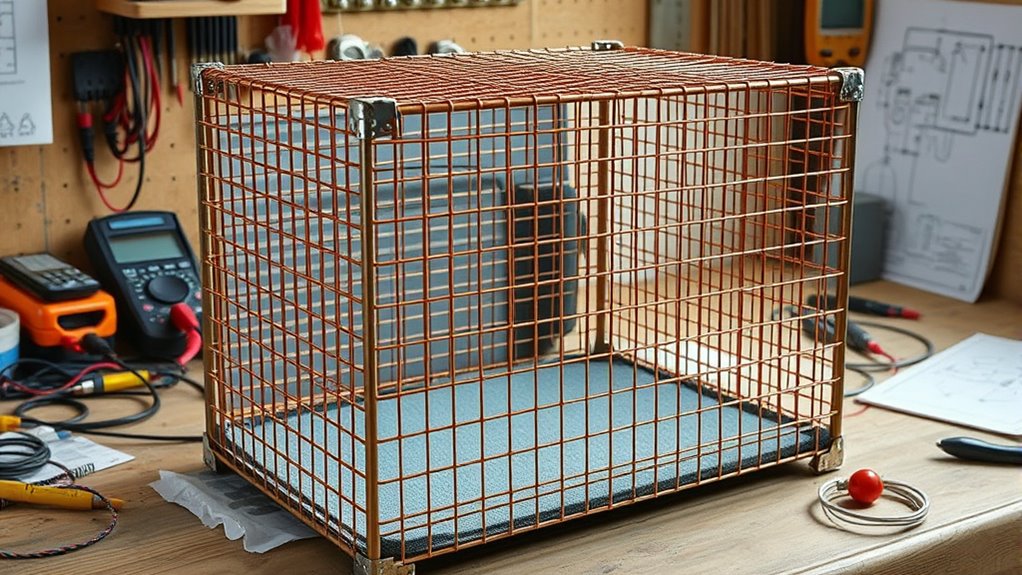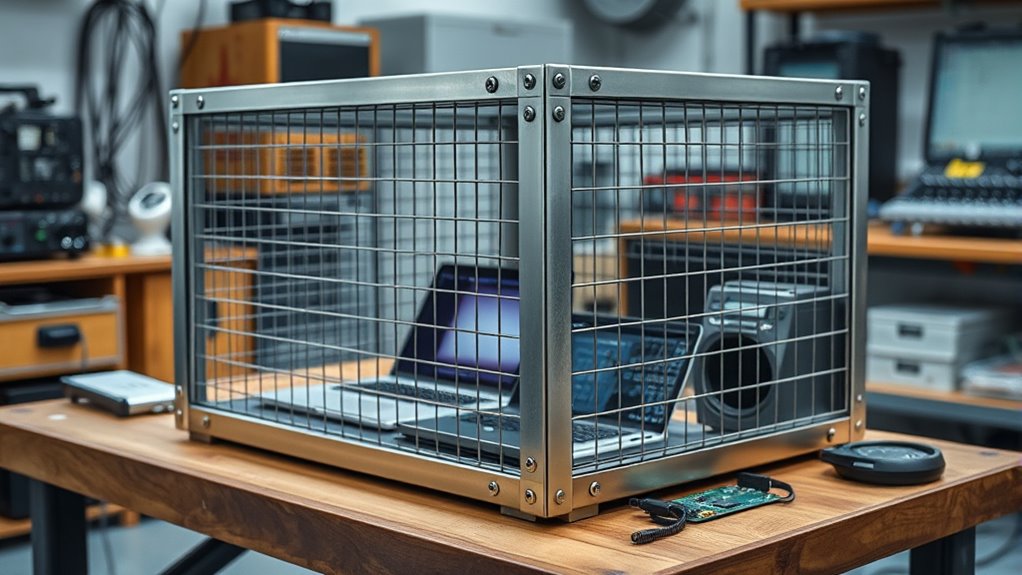To protect your electronics from EMPs, using a Faraday cage is a smart choice. These conductive enclosures redirect electromagnetic energy around your devices, preventing damage. Make sure the cage is made from copper, aluminum, or steel, with tight seals and grounding for maximum effectiveness. Properly designed, well-maintained Faraday cages can shield your gadgets from EMPs, solar flares, and other electromagnetic threats. Keep exploring to learn the best materials, designs, and maintenance tips for robust protection.
Key Takeaways
- Faraday cages redirect electromagnetic energy around their interior, preventing EMP-induced damage to enclosed electronics.
- Use conductive materials like copper, aluminum, or steel for effective shielding; ensure continuous coverage without gaps.
- Proper grounding dissipates induced currents, enhancing the cage’s ability to protect against EMPs and other electromagnetic threats.
- Test the cage’s effectiveness by placing a device inside and verifying signal blocking or reception; seal all edges tightly.
- Regular maintenance, including inspecting for damage and ensuring proper grounding, is essential for sustained EMP protection.
Understanding Electromagnetic Pulses and Their Impact on Electronics

Electromagnetic pulses (EMPs) are sudden bursts of electromagnetic energy that can disrupt or damage electronic devices. When an EMP occurs, it causes electromagnetic interference that can overwhelm circuits, leading to malfunction or complete failure. You might notice your devices acting erratically or shutting down unexpectedly. Power surges often accompany EMPs, delivering a sudden spike of electricity that can fry sensitive components. Unlike typical electrical issues, EMPs affect multiple devices simultaneously and can bypass traditional protection methods. Understanding this impact helps you grasp why robust shielding is essential. Proper shielding techniques are critical to prevent damage from these high-energy bursts. By recognizing how electromagnetic interference and power surges threaten electronics, you can better prepare and take steps to safeguard your devices from potential EMP damage. Additionally, advancements in AI Security technologies contribute to developing more effective protective measures against electromagnetic threats. Implementing effective Faraday cages can also significantly reduce the risk of damage by blocking electromagnetic fields from reaching your devices.
The Science Behind Faraday Cages and How They Work

A Faraday cage works by creating a conductive enclosure that redirects electromagnetic energy around its interior, preventing it from reaching sensitive electronic devices. The cage’s effectiveness depends on material conductivity; highly conductive materials like copper or aluminum allow electromagnetic waves to flow easily, dispersing the energy safely. Grounding effectiveness is also essential—when the cage is properly grounded, it offers a direct path for electrical charges to dissipate, enhancing protection against EMPs. The design ensures that the electromagnetic fields induce currents on the cage’s surface, which then cancel out the incoming pulses. This process keeps the interior shielded, safeguarding your electronics from damage. Additionally, selecting the right materials and ensuring proper grounding techniques are crucial for maximizing the cage’s protective capabilities. Properly maintained, a Faraday cage can effectively protect sensitive electronics from electromagnetic threats, including solar flares and EMP events. Considering the size and shape of the cage is important to ensure complete coverage and optimal shielding. Moreover, understanding the role of grounding can help optimize the cage’s effectiveness in different scenarios.
Materials and Designs for Effective EMP Shielding

Choosing the right conductive materials is key to building effective EMP shields, as different options offer varying levels of protection. You’ll also want to contemplate cage design strategies that maximize coverage and minimize gaps. By understanding these material choices and design principles, you can better safeguard your electronics from EMP damage.
Conductive Material Choices
When selecting conductive materials for EMP shielding, durability and conductivity are crucial factors that determine effectiveness. Metals selection plays a key role; copper, aluminum, and steel are common choices due to their high conductivity and availability. Copper offers excellent conductivity but can be costly, while aluminum provides a lightweight, affordable option with good shielding properties. Steel, especially galvanized or stainless, adds durability but has lower conductivity. Conductive coatings are also useful for enhancing existing surfaces or creating flexible shields, offering a cost-effective alternative to metals. These coatings, often made from conductive paints or sprays, can be applied to non-metallic surfaces to improve EMP protection without adding bulk. Additionally, understanding the conductivity properties of different materials helps optimize the shield’s overall performance and durability. For instance, material compatibility is important to ensure that the conductive coatings adhere properly and function as intended. A thorough understanding of electrical conductivity can guide better material choices for specific applications. For example, tuning modifications in vehicles showcase how material choices can influence performance and resilience, which parallels selecting appropriate materials for EMP shielding. Carefully choosing the right combination of metals and conductive coatings ensures your Faraday cage provides reliable, long-lasting EMP shielding. Incorporating vibrational energy considerations can further enhance the effectiveness of your shielding solutions by aligning them with environmental factors.
Cage Design Strategies
Effective EMP shielding depends not only on selecting the right conductive materials but also on designing cages that maximize protection. A well-designed Faraday cage uses strategic mesh patterns to balance conductivity and accessibility, ensuring EMP waves are reflected or absorbed. Incorporate structural reinforcements to prevent gaps or weak points that could compromise shielding. Consider the following design elements:
| Mesh Pattern | Reinforcement Type |
|---|---|
| Fine Mesh | Metal rods or frames |
| Coarse Mesh | Rigid metal sheets |
| Hybrid | Combination of mesh and reinforcements |
Choosing the right combination of mesh patterns and structural reinforcements creates a robust cage that minimizes EMP penetration while maintaining durability and ease of access. Proper design enhances overall effectiveness and longevity. Additionally, selecting appropriate materials that are highly conductive and corrosion-resistant further improves shielding performance.
Step-by-Step Guide to Building Your Own Faraday Cage

Have you ever wondered how to build a simple yet effective Faraday cage to protect your electronics from EMP attacks? Start by selecting a suitable metal mesh, ensuring it’s conductive and tightly woven. The cage size depends on what you need to protect; it should be large enough to hold your devices comfortably, with some extra space around them. Cut the mesh to size, leaving a few inches of overlap for sealing. Use conductive tape or a metal clasp to secure the edges, creating a continuous conductive barrier. Make sure there are no gaps or holes, as these could compromise the shield. Once assembled, test your Faraday cage by placing a device inside and checking for signal reception. Incorporating proper grounding techniques can further enhance the effectiveness of your shield. Additionally, understanding personality traits can help in personal resilience and preparedness strategies. With these steps, you can build an effective EMP shield at home.
Commercial Options for EMP Protection Enclosures

If you’re looking for reliable EMP protection enclosures, numerous commercial options are available that offer convenience and proven shielding effectiveness. These commercial enclosures are designed specifically for EMP shielding, ensuring your electronics stay safe during an electromagnetic pulse. Many are made from materials like conductive metals or coated fabrics that block electromagnetic fields effectively. You can find ready-made Faraday cages, cabinets, and bags that meet industry standards for EMP protection. These options are ideal if you prefer a quick, hassle-free solution without building your own enclosure. When choosing a commercial enclosure, consider factors like size, portability, and the level of EMP shielding needed. Additionally, verifying that these products are tested and certified for shielding effectiveness can provide added assurance. Using properly designed enclosures enhances the reliability of the protection, making sure your sensitive electronics are safeguarded. Incorporating industry standards into your selection process ensures that the enclosures meet recognized benchmarks for electromagnetic shielding. Selecting products with certification and testing ensures they meet rigorous standards for electromagnetic shielding. With these products, you gain peace of mind knowing your electronics are protected by tested, certified commercial enclosures. For added confidence, look for enclosures that incorporate advanced shielding materials proven to block high-intensity pulses effectively.
Best Practices for Maintaining and Using Your Faraday Cage

Once you’ve selected a reliable commercial EMP protection enclosure, maintaining its integrity becomes key to ensuring ongoing protection. Regular maintenance routines help identify and fix any damage or wear that could compromise shielding. Check for loose or damaged seams, rust, or corrosion, and repair as needed. Follow proper storage protocols by keeping your Faraday cage in a cool, dry place away from sharp objects or chemicals that could damage the enclosure. When not in use, store electronics inside the cage with minimal handling to prevent accidental breaches. Keep the interior clean and dry to avoid corrosion that might weaken the shielding. Incorporating proper placement ensures optimal airflow and reduces the risk of damage, which is essential for maintaining effectiveness. Additionally, understanding AI vulnerabilities can help in assessing the risks associated with electronic devices stored within your Faraday cage. Regular inspections and protective measures can further enhance the durability of your Faraday cage, ensuring it remains effective, providing reliable protection against EMP threats when needed most. Moreover, paying attention to shielding materials helps in maintaining the enclosure’s effectiveness over time.
Additional Strategies for Protecting Electronic Devices From EMPS

Grounding techniques can be highly effective in dispersing EMP energy before it damages your devices. Using surge protection devices adds an extra layer of defense by blocking sudden power surges caused by EMPs. Together, these strategies help strengthen your overall protection plan against electromagnetic threats.
Grounding Techniques Effectiveness
Grounding techniques are a essential part of safeguarding electronic devices from electromagnetic pulse (EMP) effects. Proper electrical grounding helps redirect surge energy safely into the earth, reducing damage. The effectiveness of grounding methods depends on correct installation and maintenance. To maximize protection, guarantee your grounding system:
- Has low resistance connections to the earth
- Uses grounded conductors that are properly attached
- Incorporates grounding rods or mats suited for your environment
These strategies provide a reliable path for EMP-induced currents, preventing them from damaging sensitive electronics. Remember, good electrical grounding minimizes the risk of voltage surges, enhancing your overall EMP defense. Regularly check your grounding connections and maintain components to guarantee they remain effective over time. Proper grounding is a critical layer in your multi-faceted EMP protection plan.
Surge Protection Devices
Surge protection devices (SPDs) are essential tools for defending your electronic equipment against the intense voltage spikes caused by electromagnetic pulses. They work by diverting excess voltage away from sensitive devices, preventing damage. Installing a circuit breaker with surge protection guarantees your entire system is safeguarded against power surges. When a power surge occurs, the SPD senses the spike and quickly redirects the excess energy, reducing the risk of overheating or frying your electronics. Consider placing SPDs at main electrical entry points or outlets where critical devices are connected. Using SPDs alongside other protective measures, like grounding techniques and Faraday cages, creates a multi-layer defense against EMP effects. Proper installation and regular maintenance of surge protection devices keep your electronics safe during unexpected power surges or EMP events.
Frequently Asked Questions
Can a Faraday Cage Protect Against All Types of EMPS?
You wonder if a Faraday cage can protect against all types of EMPs. While Faraday cages effectively shield against many electromagnetic spectrum events by blocking electromagnetic fields, their effectiveness depends on the shielding materials and cage design. High-energy EMPs might still penetrate poorly designed cages. So, no, a Faraday cage can’t guarantee protection from all EMPs, especially powerful or unusual ones, but it markedly reduces vulnerability when properly constructed.
How Long Can Electronics Survive Inside a Faraday Cage During an EMP?
Imagine a spaceship in a lightning storm, protected by a Faraday cage that acts like a shield. During an EMP, your electronics inside can survive as long as the cage remains intact, thanks to inductive shielding and proper grounding techniques. Their survival time depends on the strength of the EMP and the cage’s quality, but if undamaged, electronics can withstand the blast for minutes or even hours.
Are There Portable Faraday Cages Suitable for Mobile Devices?
You’re wondering if portable enclosures for mobile shielding exist. Yes, there are compact, portable Faraday cages designed specifically for mobile devices. These enclosures are lightweight, easy to carry, and effectively block electromagnetic interference, including EMPs. They provide a convenient way to protect your smartphones, tablets, and other electronics on the go. Just make certain the enclosure is well-made and properly grounded for maximum protection during EMP events.
What Are Common Mistakes to Avoid When Building a Faraday Cage?
You’d think building a Faraday cage is simple, but miss these common mistakes, and your electronics might just stay vulnerable. Don’t neglect material selection; cheap or conductive-inappropriate materials won’t do. And forget proper grounding, and your cage could act more like an antenna than a shield. Ironically, the most overlooked step is ensuring all gaps are sealed—otherwise, your precious devices aren’t protected, no matter how fancy your materials are.
How Do Environmental Factors Affect a Faraday Cage’S Effectiveness?
Environmental factors like ground conditions and material conductivity can impact your Faraday cage’s effectiveness. If you build it on uneven or damp ground, electrical grounding might be compromised, reducing shielding. Using materials with poor conductivity can create gaps or weak spots, allowing electromagnetic waves to penetrate. To guarantee maximum protection, choose high-conductivity materials and select a stable, dry grounding environment, maintaining proper contact and continuous coverage.
Conclusion
Now that you know how Faraday cages can protect your electronics from EMPs, aren’t you ready to build or buy your own shield? Imagine your devices safely tucked away, untouched by destructive pulses, ready to function when you need them most. With the right materials and maintenance, you can guarantee your tech stays secure. Isn’t safeguarding your digital life worth a little effort today to prevent chaos tomorrow?










